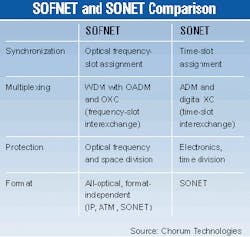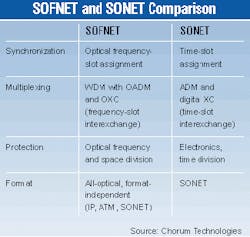New transport technology promises greater bandwidth
By ROBERT PEASE
TECHNOLOGYEfficient use of DWDM in the transport network has become critical to bandwidth and service providers, and new technologies are being introduced to address the need for network planners to grow their networks without interfering with operations during the upgrade. For example, a new transport network concept called Synchronous Frequency Network (SOFNET) enables the network to be synchronized in the optical frequency domain where hundreds of DWDM channels can be grouped or groomed at channel spacings of 25 GHz or less.
According to its developer, Chorum Technologies Inc. (Richardson, TX), the SOFNET approach allows for dramatic simplification of the network and greater scalability than that afforded by SONET. At a recent optical-networking conference, a carrier representative remarked that five years from now, his company will need the ability to go out into the field and build, in just one day, the equivalent capacity that today takes a full year to complete. Chorum believes the only way to accomplish that feat is through simpler and more efficient network architectures.
A major crossconnect hub, or the location where network traffic from thousands of individual fibers is swapped between various fiber routes, is one of today's most complex and congested areas within any network architecture. Even with SONET and some of the current DWDM systems, crossconnecting traffic remains a very complicated and expensive proposition. Optical crossconnects with thousands of ports must process the traffic-wavelength by wavelength. With SOFNET, contends Chorum, networks can be built with substantially smaller and simpler crossconnect offices.
In traditional SONET architecture, synchronization is accomplished through time-slot assignment and data rates are handled in the range of gigabits per second. By comparison, SOFNET uses optical frequency-slot assignment and enables data rates in the terabit-per-second range. Frequency-domain optical protection can also be implemented, potentially replacing the electronics necessary for SONET's time-division protection features.
Since DWDM runs the signal in the optical frequency domain, the concept of frequency-slot assignment can be implemented. Chorum refers to this as frequency-division multiplexing (FDM). Unlike in the time domain where bandwidth is assigned to time slots based on clock recovery, FDM uses channel spacing to assign the bandwidth slot. The assumption is based on optical channel spacing being wider than the bandwidth required by the electronic modulation.
Chorum's key enabler for FDM is a relatively new component called an optical slicer interleave filter. The optical slicer interleaver can "slice" the more than 40-THz fiber bandwidth (1,300- to 1,600-nm) into multiple optical frequency trains. Each frequency train can be multiplexed, managed, and used for protection, forming the basis for the SOFNET architecture.Using interleave filtering technology to perform wavelength management has several advantages, according to Chorum. All channels in the frequency "train," or path, are filtered at once, eliminating the requirement for high loss and complex optical multiplexers and demultiplexers, as well as hundreds of optical switches and other optical gear. Bulk wavelength processing can be particularly cost-effective and efficient when compared to some of today's DWDM schemes. Additionally, the filtering characteristics of optical slicing interleavers are also attractive to the customer, since they can support hundreds of OC-192, and even OC-768, signals.
For example, a 1x4 optical slicer interleaver at 25-GHz input spacing could produce four 100-GHz frequency trains for ring or mesh connectivity. Compared with a single OC-192 SONET wavelength with a capacity of 10 Gbits/sec, the capacity produced would be 2.5 Gbits/sec multiplied 400 times. These frequency trains can be routed within a ring or mesh environment.
"The concept is similar to the subway system, where multiple color trains pass through the stations," says Jian-Yu Liu, co-founder, chief technology officer, and vice president of engineering at Chorum. "Some of the trains are express, with no passengers getting on or off, and some of them stop at every station to load and unload passengers or change trains."
This frequency train concept, says Liu, enables the network planner to plot the map of traffic growth and direct the routes as needed. Add/drop and crossconnect functions are part of the planning as the network grows.
One of the most important features of traditional SONET is its protection and restoration functionality. This usually requires a percentage of the bandwidth to be reserved for restoration. SOFNET can provide the same features, say the Chorum sources.
A simple example would be two sets of 100-GHz-spaced DWDM trains offset by 50 GHz routed between two nodes. In normal operation, each would be routed along a separate path. If one path breaks, the protection switch directs the traffic from the broken path and combines it with signals on the second path. A receiving optical slicer interleaver then separates the paths again. The rerouted traffic is finally sent to its original destination via the protection switch.
Using 1x4 or 1x8 slicers, more DWDM trains are available to form a more complicated mesh network. Depending on the service, restoration can be provided by one train, or 25% in the case of a 1x4 slicer interleaver and 12.5% for a 1.8 slicer interleaver.
Liu believes we're not far from seeing some major shifts in communications technologies as the requirement for more bandwidth continues to outpace legacy systems.
"The coming data tidal wave has just begun," says Liu. "Digital-subscriber-line data rates are insignificant as compared to what will be required in the future to support such advanced applications as real-time medical imaging and holographic video. With [such applications in mind], there must be a mechanism to efficiently and cost-effectively deal with this tremendous surge in traffic."
Chorum Technologies believes Inter net Protocol (IP)-based communication will be the dominant scheme for tomorrow's next-generation networks. It offers a less expensive and simpler means to rapidly scale the network. However, SONET will likely remain-at least until IP proves it can effectively handle voice traffic with the same quality and reliability as today's public-switched telephone networks.
But once it does, says Liu, change will occur rapidly.

